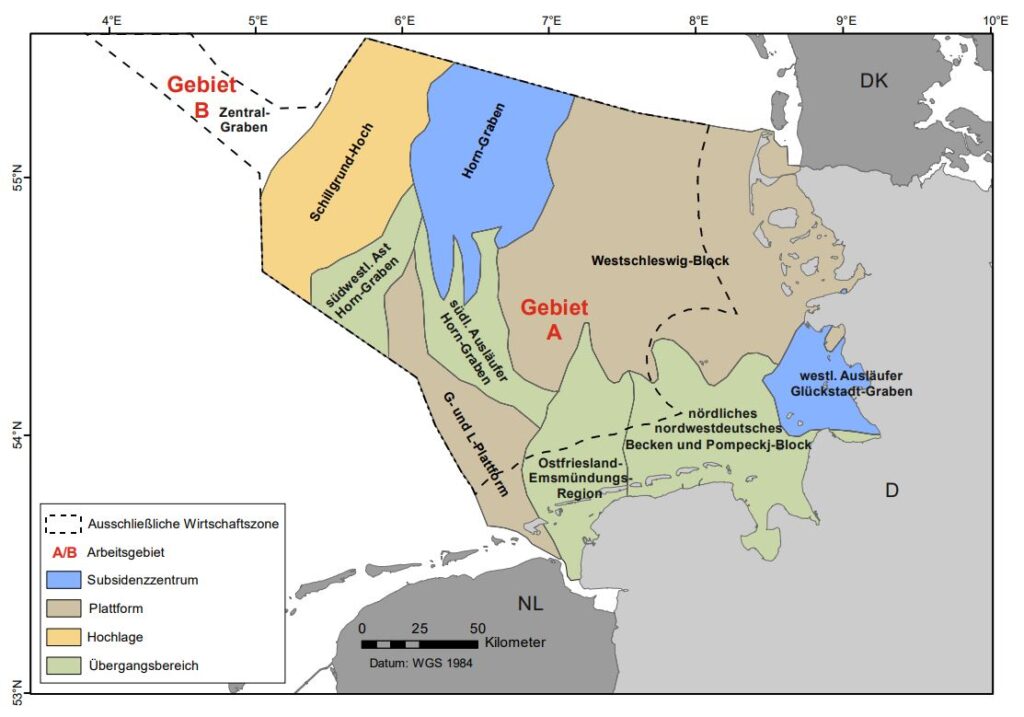Geology
To estimate the storage capacity in the German North Sea sector, the following questions are addressed in the project.
How large is the CO2 storage capacity in the subsurface of the German North Sea sector?
So far, there are only rough and incomplete estimates of the storage capacity in the German North Sea sector (excluding the so-called ‘Entenschnabel’ ) amounting to 3.6 – 10.4 billion tons of CO2 (Willscher 2007) or 1.9-4.5 billion tons (Vangkilde-Pedersen et al., 2009). These values are based on estimates of the ‘usable’ pore volume of many individual storage structures, i.e., trap structures in sandstone formations that are covered by barrier rocks and therefore could in principle be suitable for storage.
Accordingly, a large part of the CO2 emissions that will be generated by the German industry in the coming decades that cannot be avoided by production conversions (approx. 30 – 90 million tons of CO2 per year) could be stored in the geological subsurface of the North Sea.
In all previous estimates of storage capacities, the rocks of the Upper Cretaceous were not considered and those of the Rotliegende only incompletely. These gaps are now to be closed in the project. In addition, the CO2 storage capacity in the so-called ‘Duck’s Bill’ is to be investigated for the first time. This will result in a more comprehensive and accurate estimation of the storage capacity in the German North Sea sector.
How much CO2 can actually be stored?
The existing pore space in storage formations can only partially be filled with CO2 because the injected CO2 is not distributed throughout the pore space due to the nature of the storage rock. In addition, overpressures can develop in the subsurface during CO2 injection, which means that the injection rate must be reduced and possibly only a smaller amount of CO2 than predicted can be stored. Strong overpressures must be avoided because they compromise the integrity of the storage and/or barrier rocks, increasing the risk of CO2 leakage. In addition, they can trigger seismic events in the subsurface, potentially endangering infrastructure on or in the seabed (environment).
In order to determine the usable pore space, i.e. the pore space that can be filled with CO2, thestorage in two selected areas will be simulated with the aid of computer models that represent the different complexities of the geological subsurface in the North Sea region.
For this purpose, detailed geological 3D models of the subsurface are developed for the two areas.
Subsequently, CO2 injection and storage of up to 10 million tons of CO2 per site and year will be simulated at a storage structure in each area. The simulations will take into account the dispersion of CO2 in the subsurface, the displacement of formation water, and the development of pressure in the subsurface. In addition, it will be investigated whether the stored CO2 remains in the storage formation or can escape along faults (environment).
The actual amount of CO2 that can be stored at these sites is further limited by additional factors (e.g., economic considerations, regulatory requirements, (geo)technical aspects) that can only be determined during site exploration and detailed planning for a specific CCS project.
Team:
Prof. Dr. Sebastian Bauer (CAU)
Firdovsi Gasanzade (CAU)
Dr. Frithjof Bense (BGR)
Fabian Jähne-Klingberg (BGR)
Stefan Knopf (BGR)
Dr. Gesa Kuhlmann (BGR)
Dr. Heidrun Stück (BGR)
Dr. Björn Zehner (BGR)
Weiterführende Informationen
https://www.bgr.bund.de
Literature
Willscher, B. (2007) Die CO2-Speicherkapazität in salinen Aquiferen in der deutschen Nordsee. Bundesanstalt für Geowissenschaften und Rohstoffe, Hannover.
Vangkilde-Pedersen, T.: EU GeoCapacity, 2009. Assessing Europe Capacity for Geological Storage of Carbon Dioxide. D16 WP2 Storage Capacity., 170 pp., 2009.
